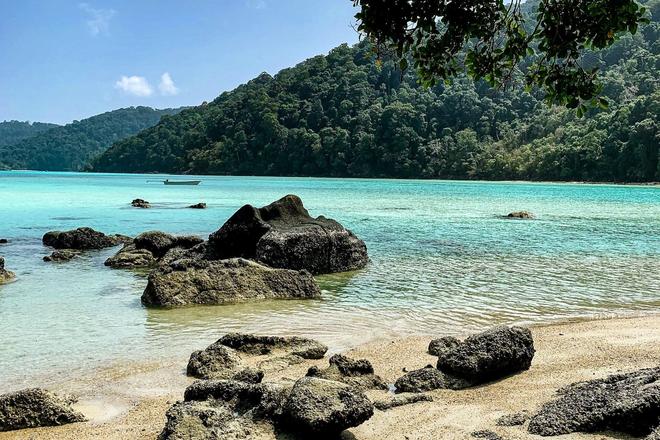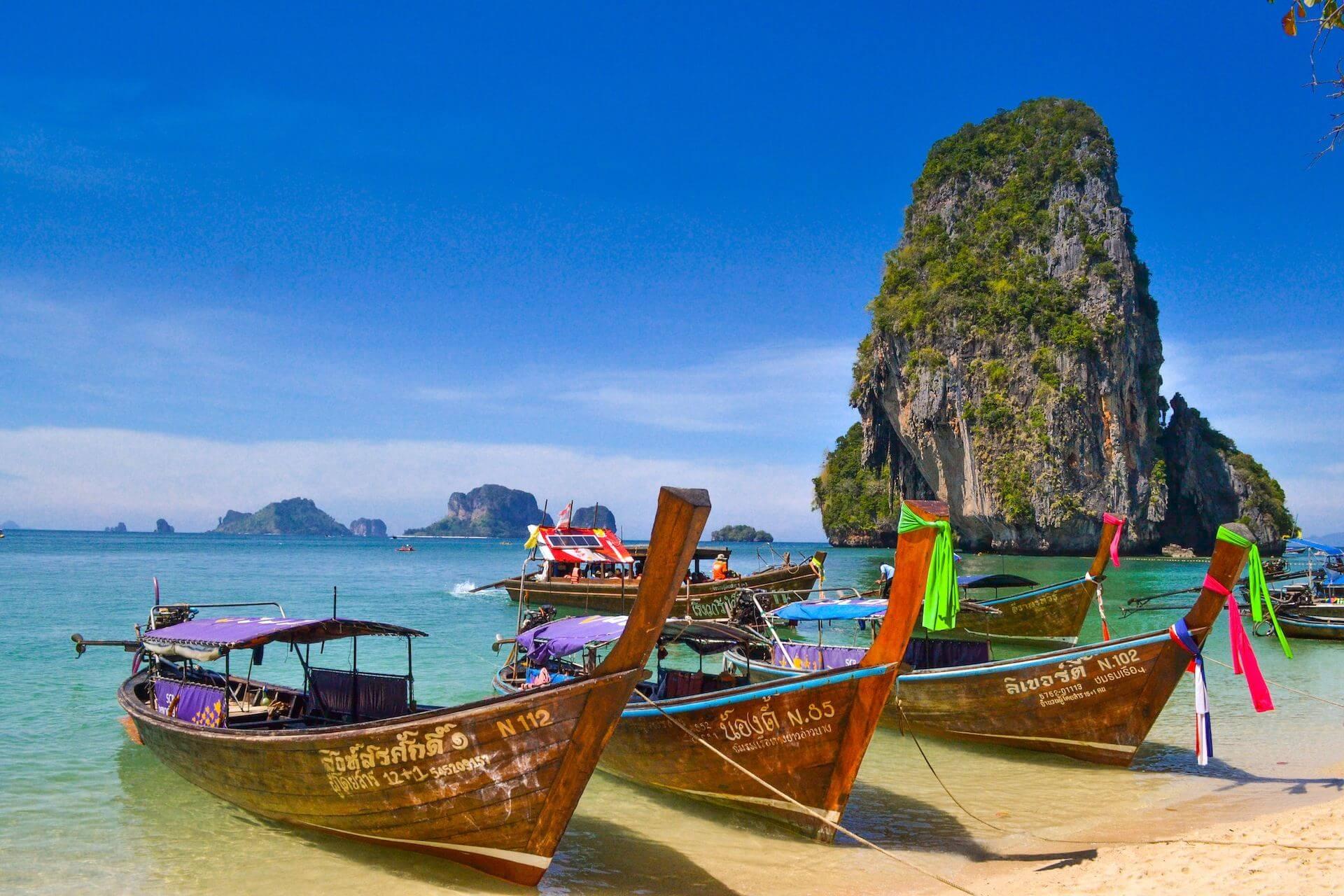The white sand of the beaches merges into the sea of a soft turquoise colour, which gradually, shade by shade, darkens until it turns into a rich, dark blue behind the coral reef. Further out, the horizon is lined with a wall of rock towers of all shapes, which hide caves and lagoons. Tiny islands are inhabited by several small resorts and dense forests. You can spend time here actively sea kayaking or enjoying a quiet and relaxing holiday. Evenings here are peaceful, quiet and intimate – just like the islands themselves.
The size of the islands and transport
The largest island, Ko Libong, measures just under nine kilometres in width and length, the smaller Ko Muk measures just over four kilometres and the uninhabited Ko Ngai and Ko Kradan just over three kilometres. All of the islands lie wholly or partially within national parks, with Ko Ngai in Mu Ko Lanta National Park, and Ko Kradan, Ko Muk and Ko Libong in Chao Mai National Park, which is also on the mainland. There are several kilometres of roads and unpaved paths and two villages on Ko Libong Island, motorbike paths connect the villages on Ko Muk Island, and only a few footpaths on Ko Kradan and Ko Ngai Islands.
There are several ways to reach the islands. In the high season, tourist boats operate on the route from Koh Phi Phi and Ko Lanta further south to Koh Lipe. From the mainland, boats run to the islands from several ports, the main entry point to Koh Ngai is Pak Meng Port, while boats run to Koh Kradan and Koh Muk from Kuangtungku Port. There are no regular boats between these islands, but you can hire local boatmen on each island to take you to nearby islands or for snorkelling. There are boats to Koh Libong from the port of Haad Yao. All ports can be reached by minibus or taxi from the bus station in Trang.
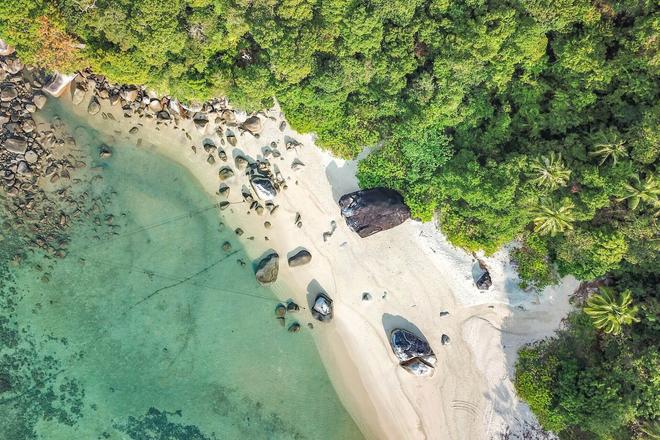
KO LIBONG
Begin your journey along the southern Andaman coast on the largest and southernmost of the islands in this group, Ko Libong. Like many of the other islands here, it is rocky from north to south, while the eastern part of the island is flat, low-lying and covered with extensive dense and very old mangrove forest.
Mangrove forests home to the dugong
Another unique feature of the island is related to the shallow sea and mangroves here – the nutrients from the mangrove forests and the muddy seabed make it a thriving habitat for seagrass, which is sought after by up to three-metre-long endangered marine mammals, the dugong. They are very shy animals and being in the middle of their herd is a fantastic experience. They hardly come above the surface at all, but every few minutes they stick their snouts out to breathe loudly. There are tours to see the dugongs, but you can also watch them from the observation tower on the south coast and from one of the coastal hills. At high tide, the mangrove forest feels like you're sailing through a flooded jungle, with the green canopy of the mangrove canopy looming over you.
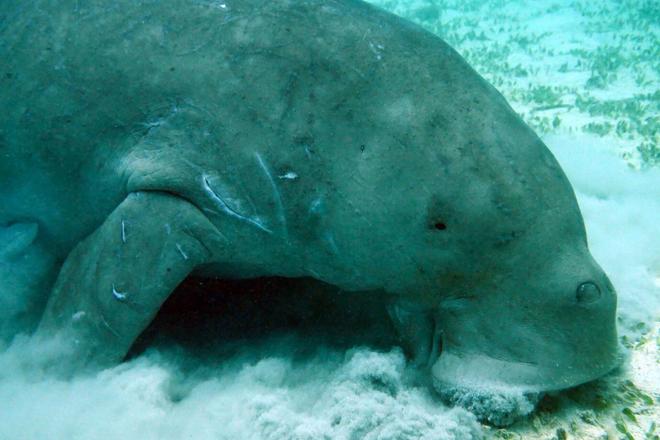
Villages and beaches of Ko Libong
Roughly in the middle of the island's northern coast lies the port of Ban Phrao, where boats arrive from Haad Yao pier on the mainland. Other fishing villages include Ban Ba Tu Pu Pe on the south coast and Baan Lang Khao on the west. Between the villages are several narrow roads and unpaved paths that can be traversed by motorbike. Along the way you will see the truly traditional life of a non-touristic Thai island. Like most of the Thai coastline, Koh Libong is predominantly Muslim, so it's a good idea to dress appropriately.
On the eastern part of the north coast is a beautiful beach nearly three kilometres long, with fine white sand and resort accommodation near the harbour. Almost all the other resorts are on Haad Lhang Kao beach on the west coast, where there is also the small village of Ban Lhang Kao with several local restaurants and shops. The beach here is relatively shallow and very close to shore where the extensive coral growth starts, which is fantastic for snorkelling, although you can't swim here at low tide. Coral also grows on the rocky seabed leading to the rocky islet of Koh Kwang. From this beach there are also spectacular views of the open sea, interrupted by rocky islets in places, in the northwest you can see Ko Kradan, Ko Muk and partly also Ko Ngai and the sunsets from here are absolutely breathtaking.
KO MUK
The shape of this island is extremely interesting, as is its geography – in the east, a sharp point rises towards the mainland, formed by the beautiful Haad Sivalai beach with its fine sand, from where the island spreads out in an almost perfectly symmetrical north-south direction towards the west, rising in height to close in on the west coast in the form of dramatic, high and perpendicular walls falling into the sea. To the east of the island, just beyond the tip of Haad Sivalai beach, two local Muslim villages, designated Ban Koh Muk, lie almost symmetrically opposite each other, like the whole island – one on the north coast and the other on the south. These villages have small shops, a few simple local eateries and restaurants for tourists. You can also hire boatmen for trips around the island.
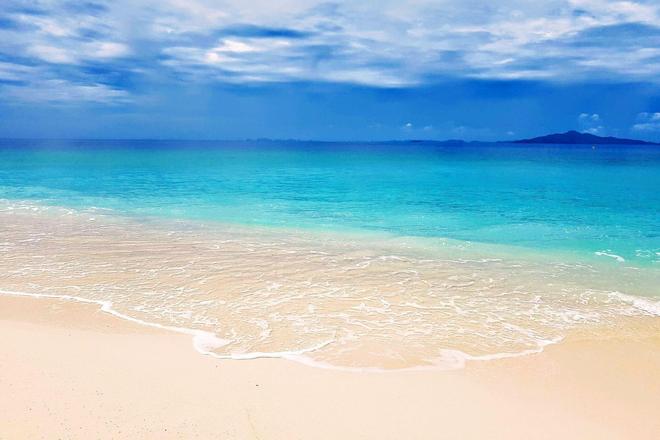
Emerald Cave Tham Morakot
The western part of the island hides one remarkable natural formation called Tham Morakot (Emerald Cave), where tourists come from as far as Ko Lanta and other places to see. You take a boat to a 150-metre high rock wall that drops perpendicularly into the depths, pay the entrance fee, jump off the boat and with a torch, swim through a dark, 80-metre long tunnel through the interior of this massive rock into a small lagoon, which is a pool of seawater lined in an almost perfect circle by rock walls. With the right lighting, a narrow cone of light falls directly onto the surface of the pool. The best time to visit is early morning or late afternoon, but the possibility of visiting the cave depends very much on the level of the tide – at high tide the tunnel is completely flooded and the cave is therefore inaccessible. If you have the experience and equipment, you can also go to the cave yourself by sea kayak, the route is less than two kilometres long and you can rent a plastic kayak at the nearby Haad Farang beach, also called Charlie beach.
Walking trips to Haad Farang and Sabai beaches
From the southern village on the island, a footpath leads to the west coast to the aforementioned Haad Farang beach in a beautiful bay with several resorts and restaurants. The road here is just over one kilometre long.
There is also a path from the village through plantations and forest northwards to Haad Lodung beach, which is shallow for swimming at low tide but has beautiful views. The trail then continues through the forest past the rock towers to the tiny hidden Sabai beach on the west coast, which is a beautiful little cove flanked on both sides by massive rocks. One trip from the village should take around two hours, so it's best to leave in the morning or early afternoon to make it back before dark. Also take plenty of drinking water for the return journey – there are no facilities or shops on the beach or along the way. For safety reasons, women should not take this route alone.
KO KRADAN
The tiny, elongated island of Koh Kradan is like something out of a tropical holiday advert. Most of the east coast is made up of beautiful beaches with incredibly fine and white sand. Along it stand peaceful resorts with bungalows and restaurants just steps from the sea. Some have diving centres and you can also arrange boat trips to the Tham Morakot cave or around the islands.
A coral reef stretches almost the entire length of the shoreline with snorkelling opportunities. On the west side you will find three smaller beaches where you can also snorkel, but there tend to be large waves and strong winds from the open sea. Near the National Park Authority on the south east coast, signs point to the Paradise Lost resort, which sits on a hill inland in the thick jungle. Here you can freshen up and continue further west where there is a beautiful little beach called Sunset Beach.
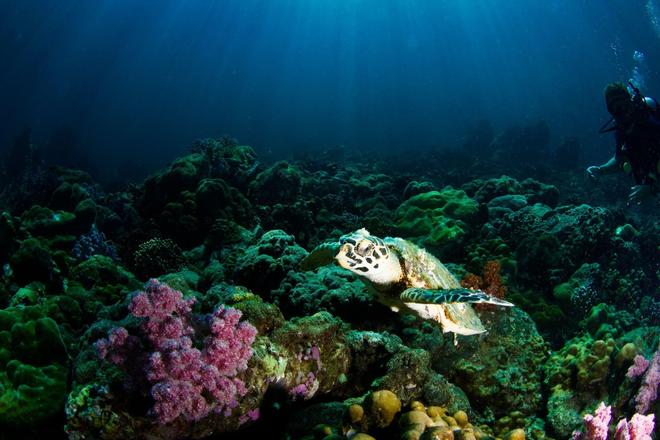
KOH NGAI
The uninhabited island of Koh Ngai, also called Koh Hai, is very close to the islands of Koh Kradan and Koh Muk. It has a very interesting shape – the northern tip forms a pointed rocky promontory and towards the south the island expands symmetrically. The south-western and south-eastern ends are formed by other rocky promontories, between which are the arches of two beaches separated by another rocky headland.
Almost the entire eastern coastline is a beautiful white sand beach fringed by a coral reef. Almost all of the island's resorts are concentrated here and there are several diving centres. From the east coast, the white sands offer fantastic views of the turquoise sea, the rocky islet of Koh Cheuk and the cliffs near Pak Meng harbour on the mainland. At the southern end of the beach is a pier where tourist boats stop on the route between Ko Lanta and Koh Lipe. The west coast is wild and rocky, exposed to the violent waves and winds of the open sea. On the southwestern tip of the island lies the National Park Authority and a lookout hill, which is an ideal place to watch the sunset. You can get here on foot from the main beach on the east coast, and on the way back you can take a boat taxi from a beach called Paradise Beach.
